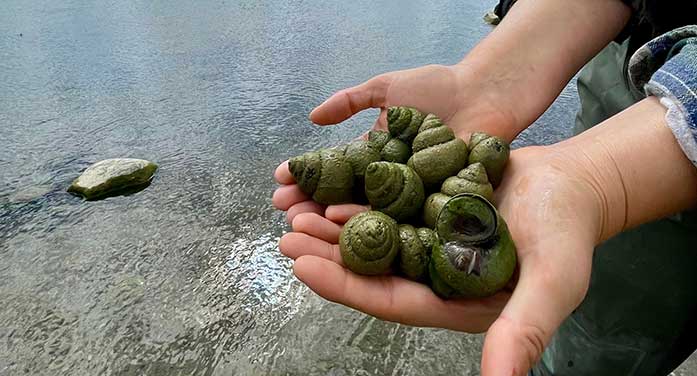
New research reveals clues to the biology of the Chinese mystery snail, an unusually large and durable invasive species found to have spread to a southern Alberta lake in 2019. (Photo: Supplied)
New research led by University of Alberta scientists could help contain the spread of the Chinese mystery snail, an invasive species whose discovery in a southern Alberta lake is as enigmatic as its name.
 Mark Poesch |
 Megan Edgar |
“Chinese mystery snails have been found throughout Eastern Canada and most of the continental United States, but to find them in Alberta was a little bit surprising,” said Mark Poesch, professor in the Department of Renewable Resources.
The unusually large snails were first identified in Lake McGregor, southeast of Calgary, by U of A scientists in 2019. Anecdotal evidence suggests they were being scooped up by local children for their aquariums years earlier, said master’s student Megan Edgar, a conservationist who has studied the ecosystem of Lake McGregor for two years. How they got into the lake in the first place is unknown, she said, but the most likely scenario is through human release.
Invasive species are one of the leading drivers of declines in aquatic ecosystems worldwide. The introduction of non-native species, intentional or unintentional, alters ecosystems when the invaders outcompete native species for space and resources and may also contribute to increased nitrogen-to-phosphorus ratios, resulting in an overall deterioration of water quality.
The Chinese mystery snail outcompetes the smaller native snails for food, adversely affecting the entire aquatic food web, Edgar explained. Its larger size and sturdy shell make it less appealing to predators, which instead feast on native cuisine. Its unique design – the shell has an operculum, or lid, which covers the aperture – effectively seals it from within like a bank vault, making it largely impervious to predators and even extremes of weather.
“When their shell closes up, they can survive in open water for up to nine weeks, which is insane,” she said. “They can also survive chemical management like copper sulfate, and in addition to their ability to withstand cold temperatures, they have a high upper thermal limit of 45 degrees Celsius.”
In other parts of the world, the Chinese mystery snail may also transmit diseases and parasites to fish and other wildlife, including humans. The study shows that the Lake McGregor snails are free of parasites for now, but the researchers noted that continued monitoring is essential.
One of the snails’ most unusual characteristics is their life cycle, Edgar explained. Alberta populations of Chinese mystery snails have 30 per cent fewer babies than populations elsewhere, which slightly mitigates their potential impact. Also, juvenile snails emerge through live birth, not eggs, and in times of stress can be reabsorbed or birthed by the mother.
“In predation scenarios, they will just pop out all their juvenile snails as a way of getting away from a predator,” she says. “It’s kind of a cool defence mechanism to give live birth immediately and then use that as a decoy.”
Further analysis shows that they have allometric growth, which means they grow longer than they grow wide, which has implications for population management as the higher surface area of the juveniles may be more susceptible to desiccation.

Master’s student Megan Edgar uses a net to collect Chinese mystery snails at Lake McGregor in southern Alberta, where the invasive species has thus far been contained in the province. (Photo: Supplied)
Once established, however, invasive species like the Chinese mystery snail are difficult, if not impossible, to eradicate. Containment is key, said Poesch.
“We did a series of surveys in other lakes and reservoirs in Alberta to see if they had spread, and so far they haven’t, which is good news,” he said. “We know that they are in McGregor Lake now, so let’s keep them there. We’re working with the government of Alberta to provide education to the public because public awareness through online tracking tools like Edd Maps – a platform to report invasive species – is going to be key to ensure we’re not spreading them.”
The study, The First Documented Occurrence and Life History Characteristics of the Chinese Mystery Snail (Cipangopaludina chinensis, Mollusca: Viviparidae) in Alberta, Canada, will be published in BioInvasions Records.
| By Donna McKinnon
Donna is a reporter with the University of Alberta’s Folio online magazine. The University of Alberta is a Troy Media Editorial Content Provider Partner.
The opinions expressed by our columnists and contributors are theirs alone and do not inherently or expressly reflect the views of our publication.
© Troy Media
Troy Media is an editorial content provider to media outlets and its own hosted community news outlets across Canada.


